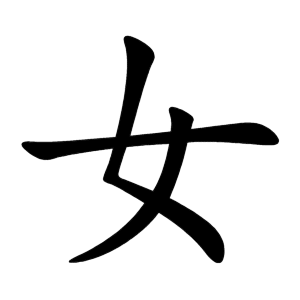女
- female, woman;
- daughter;
Etymology
Usage in Korean
Because most literate people who created these ancient characters were dominant males of the ruling class, many characters using 女 as a radical reflect gender role stereotypes from a patriarchal perspective, often attributing negative meanings to women.
Among the characters that use 女 (woman) as a radical, quite a few carry negative meanings.
Notable examples include:
嫌 (to dislike)
奸 (deceitful, crafty)
妨 (to obstruct)
The character 姦, which contains three 女 radicals, means “to commit adultery.”
Although not shown in the image, others like 奴 (slave), 妄 (delusion), and 妓 (courtesan) also carry negative connotations.
Even characters without the 女 radical, such as 肗 (to rot), can have negative meanings.
A severe example is 妥 (appropriate, proper), whose origin is said to depict a hand pressing down on a woman.
However, not all characters with the 女 radical have negative meanings. There are many with neutral or positive meanings, such as:
好 (good, to like)
始 (to begin)
姜 (a surname)
如 (to resemble, to follow)
妙 (wonderful)
姓 (surname)
委 (to entrust)
姿 (posture, appearance)
威 (majesty, dignity)
娛 (to entertain)
妖/姚 (beautiful)
嬉 (joyful, beautiful)
妟/侒 (peaceful), and more
If this radical only contained characters with bad meanings, it would be classified under radicals such as 死 (death radical) or 疒 (sickness radical), which predominantly have negative meanings.
Even among positive characters, many reflect the gender roles and realities of women at the time they were created.
For example, 如 (to resemble, to follow) is said to symbolize a woman following a man’s words, and 威 (majesty) may have originated from a man threatening a woman with an axe.
Characters with 女
- 女 (V)
- ⿻ 𡿨 丆 (G J K V)
- ⿻ 𡿨 𠂇 (H T)
